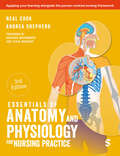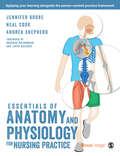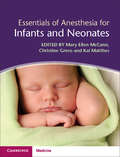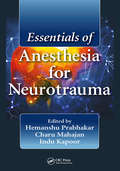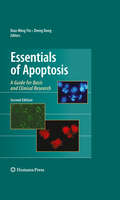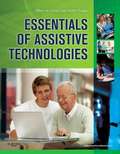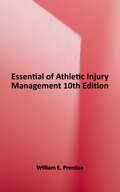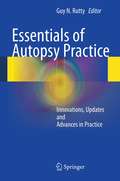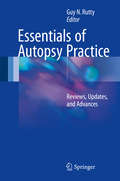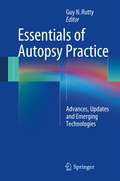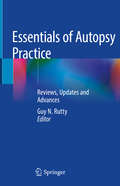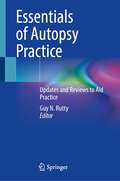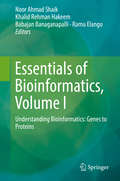- Table View
- List View
Essentials of Anatomy and Physiology for Nursing Practice
by Neal Cook Andrea ShepherdThe essential guide to anatomy and physiology for nursing students! A must read for nursing students, this third edition explores all aspects of anatomy and physiology through an inclusive person-centred lens. Here’s what sets this book apart: Focused Content: Easy to read with complex terminology clearly explained, the book introduces the systems and functions of the body, building your knowledge chapter by chapter. Four stage learning journey: Structured in four logical steps, the book helps you to UNDERSTAND the fundamentals of anatomy and physiology, APPLY it to practice, GO DEEPER into the science and REVISE through self-testing. Person-Centred Case Study Companion: Meet the Bodie family, a case study that runs through the book, illustrating how anatomy and physiology applies to real-life compassionate and inclusive nursing practice. Visual Learning: Dive into a highly visual design, packed with colourful illustrations and helpful video links.
Essentials of Anatomy and Physiology for Nursing Practice: Essentials Of Anatomy And Physiology For Nursing Practice + The Nurse's Anatomy And Physiology Colouring Book
by Jennifer Boore Neal Cook Andrea ShepherdGet 12 months FREE access to an interactive eBook* when you buy the paperback! (Print paperback version only, ISBN 9781473938465) Drawing together the best of text, video and interactive material for the complete A&P learning resource for nurses. Effective, holistic nursing is impossible without a firm grasp of how the human body functions but knowledge of the scientific theory on its own is not enough. Using the person-centred practice framework as a guiding principle, this book brings anatomy and physiology to life combining the best of print and online learning into one integrated package. Key features Connects theory with nursing practice exploring the science from the perspective of a fictional family Supported by a rich array of video material including interactive figures, animations and mini-tutorials – perfect for visual learners Full of engaging activities designed to complement self-directed learning A bank of 170 online multiple choice questions and over 800 flashcards – ideal for revision and consolidating knowledge Written with the needs of nurses firmly in mind, focusing on the essential information More than just a book! Each purchase includes 12 months access to an interactive eBook version which seamlessly blends the traditional textbook format with the best of online learning. Students can study when and how they want and make use of additional tools including search, highlighting, annotation note sharing and much more. The book is also supported by a SAGE Edge website containing complete access to videos, animations, student revision material and action plans. Lecturer resources to support your teaching, including downloadable figures from the book and a test bank of questions for assessment use, are also available. Visit https://edge.sagepub.com/essentialaandp to find out more. *interactivity only available through Vitalsource eBook
Essentials of Anatomy and Physiology for Nursing Practice: Essentials Of Anatomy And Physiology For Nursing Practice + The Nurse's Anatomy And Physiology Colouring Book
by Jennifer Boore Neal Cook Andrea ShepherdGet 12 months FREE access to an interactive eBook* when you buy the paperback! (Print paperback version only, ISBN 9781473938465) Drawing together the best of text, video and interactive material for the complete A&P learning resource for nurses. Effective, holistic nursing is impossible without a firm grasp of how the human body functions but knowledge of the scientific theory on its own is not enough. Using the person-centred practice framework as a guiding principle, this book brings anatomy and physiology to life combining the best of print and online learning into one integrated package. Key features Connects theory with nursing practice exploring the science from the perspective of a fictional family Supported by a rich array of video material including interactive figures, animations and mini-tutorials - perfect for visual learners Full of engaging activities designed to complement self-directed learning A bank of 170 online multiple choice questions and over 800 flashcards - ideal for revision and consolidating knowledge Written with the needs of nurses firmly in mind, focusing on the essential information More than just a book! Each purchase includes 12 months access to an interactive eBook version which seamlessly blends the traditional textbook format with the best of online learning. Students can study when and how they want and make use of additional tools including search, highlighting, annotation note sharing and much more. The book is also supported by a SAGE Edge website containing complete access to videos, animations, student revision material and action plans. Lecturer resources to support your teaching, including downloadable figures from the book and a test bank of questions for assessment use, are also available. Visit https://edge.sagepub.com/essentialaandp to find out more. *interactivity only available through Vitalsource eBook
Essentials of Anesthesia for Infants and Neonates
by Mary Ellen McCann Christine Greco Kai MatthesIt is estimated that 1.5 million infants undergo surgery and anesthesia in the USA each year. However, there are serious concerns within the pediatric anesthesia community regarding the safety of anaesthesia in infants and children. There is mounting evidence from animal studies that anesthetics in common clinical use are neurotoxic to the developing brain and cause long-term neurobehavioral abnormalities. Essentials of Anesthesia for Infants and Neonates provides a comprehensive guide to the special needs of infants undergoing anesthesia. It focuses on the first year of life, the time when anesthesia mortality and morbidity is highest. Chapters are illustrated in color throughout, and include sections on newborn physiology for anesthetic management, specific procedures, pain management, and topics such as regional anesthesia and sedation. Written by nationally recognized experts, this book will become an invaluable point of reference for any physician interested in pain management in the first year of life. Delivers comprehensive practical information on techniques to administer neonatal and infant anesthesia; Focuses in on the youngest, most fragile patients, allowing readers to tailor their anesthetics to this age group; Reviews and critiques anesthetic neurotoxicity in young children, discussing methods to limit exposure to neurotoxic agents.
Essentials of Anesthesia for Neurotrauma
by Hemanshu Prabhakar Charu Mahajan Indu KapoorThis book aims to provide an overview of the basics of anesthesia for neurotrauma. It showcases how management of different neurotrauma cases may differ, especially those involving spine and or polytrauma. It provides quick and easy access to understand anesthesia for neurotrauma.
Essentials of Apoptosis
by Zheng Dong Xiao-Ming YinThis is the second edition of the comprehensive, concise summary of apoptosis research. It covers the major concepts, molecular architecture, the biochemical pathways, and pathophysiological significance of apoptosis. This book provides a guideline of standard biochemical and cell biologic approaches to apoptosis bench work with an emphasis on translational clinical applications for immune disorders, cancer research, ischemia, and neuronal degeneration. Since the original publication in 2003, the apoptosis field has expanded rapidly - chapters not only need to be revised and expanded, but there is a need for all new chapters covering exciting advances in bioinformatics, systems biology, oxidative stress, etc.
Essentials of Assistive Technologies
by Albert M. Cook Jan Millar PolgarMaster the assistive strategies you need to make confident clinical decisions and help improve the quality of life for people with disabilities with this new essentials text. Based on the Human Activity Assistive Technology (HAAT) model developed by Dr. Cook, the book provides the most important coverage of the devices, services, and practices that comprise assistive technology and focuses on the relationship between the human user and the assisted activity within specific contexts. Case studies, illustrations of assistive devices, review questions, and well-developed learning objectives help you focus on the most important areas of assistive technology application.
Essentials of Athletic Injury Management
by William E. PrenticeThis book provides the information you need to manage the care of athletic injuries--from prevention, identification, and assessment of injuries to interaction with players, parents and physicians. Designed for those beginning careers in coaching, physical education and the fitness profession, this text prepares students to manage injury and emergency situations when an athletic trainer or physician is not available. Action plans, checklists and applications of universal precautions in athletic environments are included to provide the practical tools needed to get started in the field.
Essentials of Autopsy Practice
by Guy N. RuttyEssentials of Autopsy Practice: Innovations, Updates and Advances in Practice is the fifth volume in the Essentials in Autopsy Practice series, covering topics of current and future interest. Designed to keep all involved in the investigation of death abreast of changes within the field, this volume covers a wide range of topical areas which can be encountered around the world. Essentials of Autopsy Practice: Innovations, Updates and Advances in Practice covers death by drowning; deaths from extreme temperature; the radioactive autopsy; chemical contamination and the autopsy; blast injuries; forensic odontology identification; and determination of the force used to cause an injury. Useful to both trainees and consultants in all specialty areas within pathology, including forensic pathology, Essentials of Autopsy Practice: Innovations, Updates and Advances in Practice also serves as a guide to all those involved in death investigation, i.e. nurses, lawyers, paramedics and police officers.
Essentials of Autopsy Practice
by Guy N. RuttyEssentials of Autopsy Practice is dedicated to updating the modern pathologist on the issues related to the autopsy. This first volume contains 12 topical chapters which are not covered in any other text. It comprises the most recent developments in current autopsy and relevant subjects that have not yet been covered in current autopsy textbooks. This is what makes this book exceptional in its field. The book will be of interest to both trainees and consultants in all sub-branches of pathology including forensic pathology. The subject matter will also appeal to other areas of clinical medicine and will make a good reference book.
Essentials of Autopsy Practice: Advances, Updates and Emerging Technologies
by Guy N. RuttyThis book covers new and exciting topics which have emerged in the area of autopsy recently, including the three different post-mortem CT-angiography systems currently available to practitioners in this field; a highly topical chapter on the role of genetic abnormalities in the handling of drugs within the body and how this can affect the interpretation of toxicological results in relation to how the drug may have caused or contributed to death; an update on the current classification and considerations related to deaths due to hanging; a review of injuries and fatalities caused by animals including post-mortem scavenging; an authoritative review of poisons and toxins from water and the life that inhabits it; and recent advances in knowledge in the use of entomology as an investigative tool as well as knowledge related to colonisation of cadavers by insects, animals and birds. Essentials of Autopsy Practice: Advances, Updates and Emerging Technologies is a multi-subject book, aimed at different grades of practitioners, from different practice areas, covering topics that are currently discussed and anticipated to be discussed in the field of autopsy practice over the next few years.
Essentials of Autopsy Practice: Reviews, Updates and Advances
by Guy N. RuttyThis book covers topical subjects within the field of death investigation, where changes in practice have recently occurred. The topics embrace the multi-disciplinary approach required for death investigation, and address advances in the field of forensic photography, pathology, and 3D printing as applied to forensics. This volume includes chapters on high altitude deaths, the role of 3D-printing applied to forensic investigations, photogrammetry, commotion cordis (an uncommon cause of fatal cardiac arrest) and the cricoid cartilage. Essentials of Autopsy Practice: Reviews, Updates and Advances is an educational and practical resource aimed at trainees and consultants, generalists and specialists, and multi-disciplinary teams.
Essentials of Autopsy Practice: Updates and Reviews to Aid Practice
by Guy N. RuttyThis book covers topical subjects within the field of death investigation, where changes in practice have recently occurred. The topics embrace the multi-disciplinary approach required for death investigation, and address advances in the fields of forensic fractography in relation to road traffic death investigations, pathology, MicroCt and 3D printing as applied to forensics. Chapters are written in a uniform easy-to-follow format to ensure they are accessible to both specialists and non-specialists in the field. Essentials of Autopsy Practice — Updates and Reviews to Aid Practice is a practical focused resource covering the latest advances in autopsy practice, making it an ideal resource for trainees, consultants, generalists and specialists, along with multi-disciplinary teams working in this field.
Essentials of Bioinformatics, Volume I: Understanding Bioinformatics: Genes to Proteins
by Khalid Rehman Hakeem Noor Ahmad Shaik Babajan Banaganapalli Ramu ElangoBioinformatics is an integrative field of computer science, genetics, genomics, proteomics, and statistics, which has undoubtedly revolutionized the study of biology and medicine in past decades. It mainly assists in modeling, predicting and interpreting large multidimensional biological data by utilizing advanced computational methods. Despite its enormous potential, bioinformatics is not widely integrated into the academic curriculum as most life science students and researchers are still not equipped with the necessary knowledge to take advantage of this powerful tool. Hence, the primary purpose of our book is to supplement this unmet need by providing an easily accessible platform for students and researchers starting their career in life sciences. This book aims to avoid sophisticated computational algorithms and programming. Instead, it mostly focuses on simple DIY analysis and interpretation of biological data with personal computers. Our belief is that once the beginners acquire these basic skillsets, they will be able to handle most of the bioinformatics tools for their research work and to better understand their experimental outcomes.Unlike other bioinformatics books which are mostly theoretical, this book provides practical examples for the readers on state-of-the-art open source tools to solve biological problems. Flow charts of experiments, graphical illustrations, and mock data are included for quick reference. Volume I is therefore an ideal companion for students and early stage professionals wishing to master this blooming field.
Essentials of Bioinformatics, Volume II: In Silico Life Sciences: Medicine
by Khalid Rehman Hakeem Noor Ahmad Shaik Babajan Banaganapalli Ramu ElangoBioinformatics is an integrative field of computer science, genetics, genomics, proteomics, and statistics, which has undoubtedly revolutionized the study of biology and medicine in past decades. It mainly assists in modeling, predicting and interpreting large multidimensional biological data by utilizing advanced computational methods. Despite its enormous potential, bioinformatics is not widely integrated into the academic curriculum as most life science students and researchers are still not equipped with the necessary knowledge to take advantage of this powerful tool. Hence, the primary purpose of our book is to supplement this unmet need by providing an easily accessible platform for students and researchers starting their career in life sciences. This book aims to avoid sophisticated computational algorithms and programming. Instead, it focuses on simple DIY analysis and interpretation of biological data with personal computers. Our belief is that once the beginners acquire these basic skillsets, they will be able to handle most of the bioinformatics tools for their research work and to better understand their experimental outcomes.Our second title of this volume set In Silico Life Sciences: Medicine provides hands-on experience in analyzing high throughput molecular data for the diagnosis, prognosis, and treatment of monogenic or polygenic human diseases. The key concepts in this volume include risk factor assessment, genetic tests and result interpretation, personalized medicine, and drug discovery. This volume is expected to train readers in both single and multi-dimensional biological analysis using open data sets, and provides a unique learning experience through clinical scenarios and case studies.
Essentials of Bioinformatics, Volume III: In Silico Life Sciences: Agriculture
by Khalid Rehman Hakeem Noor Ahmad Shaik Babajan Banaganapalli Ramu ElangoBioinformatics is an integrative field of computer science, genetics, genomics, proteomics, and statistics, which has undoubtedly revolutionized the study of biology and medicine in past decades. It mainly assists in modeling, predicting and interpreting large multidimensional biological data by utilizing advanced computational methods. Despite its enormous potential, bioinformatics is not widely integrated into the academic curriculum as most life science students and researchers are still not equipped with the necessary knowledge to take advantage of this powerful tool. Hence, the primary purpose of our book is to supplement this unmet need by providing an easily accessible platform for students and researchers starting their career in life sciences. This book aims to avoid sophisticated computational algorithms and programming. Instead, it will mostly focus on simple DIY analysis and interpretation of biological data with personal computers. Our belief is that once the beginners acquire these basic skillsets, they will be able to handle most of the bioinformatics tools for their research work and to better understand their experimental outcomes.The third volume is titled In Silico Life Sciences: Agriculture. It focuses on plant genetic, genomic, transcriptomic, proteomic and metabolomics data. Using examples of new crop diseases-emergence, crop productivity and biotic/abiotic stress tolerance, this book illustrates how bioinformatics can be an integral components of modern day plant science research.
Essentials of Biostatistics for Public Health
by Lisa M. SullivanEssentials of Biostatistics in Public Health, Fourth Edition provides a fundamental and engaging background for students learning to apply and appropriately interpret biostatistics applications in the field of public health. Many examples are drawn directly from the author’s remarkable clinical experiences with the renowned Framingham Heart Study, making this text practical, interesting, and accessible for those with little mathematical background. The examples are real, relevant, and manageable in size so that students can easily focus on applications rather than become overwhelmed by computations. The Fourth Edition has been thoroughly updated, and now offers a new chapter on career opportunities and new case studies in each chapter focused on COVID-19. This edition will also include free access to JMP Student Edition Software, which is a streamlined version of SAS’ statistical discovery software and is well-suited to for introductory or intermediate statistics courses.
Essentials of Biostatistics in Public Health
by Lisa M. SullivanEssentials of Biostatistics in Public Health, Fourth Edition provides a fundamental and engaging background for students learning to apply and appropriately interpret biostatistics applications in the field of public health. Many examples are drawn directly from the author's remarkable clinical experiences with the renowned Framingham Heart Study, making this text practical, interesting, and accessible for those with little mathematical background. The examples are real, relevant, and manageable in size so that students can easily focus on applications rather than become overwhelmed by computations. The Fourth Edition has been thoroughly updated, and now offers a new chapter on career opportunities in biostatistics and new case studies focused on COVID-19 within each chapter. This edition also includes free access to JMP® Student Subscription (a $29.95 value). New cases based on COVID-19 highlight the importance and practical applications of biostatistics for addressing the pandemic.
Essentials of Blood Product Management in Anesthesia Practice
by Henry Liu Alan David Kaye Corey S. Scher Seth Perelman Sarah LeavittThis comprehensive book is written to inform and improve outcomes of patients in need of blood management during surgical procedures. Information is presented in an accessible format, allowing for immediate use in clinical practice.Beginning with an overview of the history of blood transfusions, early chapters present the foundational information needed to comprehend information in later chapters. Nuanced procedures, drugs, and techniques are covered, including new biologicals to assist clotting and blood substitutes. Further discussions focus on potential complications seen in blood transfusions, such as diseases of the coagulation system, pathogen transmissions, and acute lung injuries. Chapters also examine the complexities of treating specific demographics, of which include the geriatric patient and patients suffering from substance abuse. Essentials of Blood Product Management in Anesthesia Practice is an invaluable guide for anesthesiologists, surgeons, trauma physicians, and solid organ transplant providers.
Essentials of Cancer Survivorship: A Guide for Medical Professionals
by Lidia SchapiraThe growing number of cancer survivors presents a new challenge to generalists and specialists involved in their care. Prior cancer treatments may compound known comorbidities or contribute to future health risks. The ultimate success of cancer treatments ultimately depends on the meticulous management of post-cancer care, and this requires a clinical workforce that is engaged and ready. Cancer survivorship has now become recognized as an independent field of research and clinical practice. This new concise guide is intended for cancer clinicians as well as generalists and specialists who meet cancer survivors in their practices for routine check-ups or specialized consultations. With an expanding population known to have complex medical, psychosocial and emotional needs, we hope this book sparks interest and provides answers for those involved in their care.
Essentials of Cardiopulmonary Physical Therapy
by Ellen HillegassImprove your understanding of the cardiopulmonary system with Essentials of Cardiopulmonary Physical Therapy, 5th Edition. Based on American Physical Therapy Association best practices, this new edition provides comprehensive coverage of anatomy, physiology, and cardiopulmonary assessment, along with new chapters on the growing topics of the management of cardiovascular disease in women and pulmonary vascular disease. Using a practical approach, expert author Ellen Hillegass also discusses pathophysiology, pharmacology, and interventions in the outpatient setting.
Essentials of Cataract Surgery
by Bonnie HendersonThe straightforward, concise, and easy-to-read reference manual which is equivalent to having the best instructor offering guidance on what to do next and how to avoid potential complications is now available in an updated Second Edition.Essentials of Cataract Surgery, Second Edition comprehensively details every step of phacoemulsification cataract extraction surgery, from preoperative evaluation to intraoperative instruction to postoperative care. The basic elements of cataract surgery are presented in a clear and easy-to-read format.Dr. Bonnie An Henderson brings together advice and teaching techniques from the Harvard Intensive Cataract Surgical Training Conference at the Massachusetts Eye and Ear Infirmary. The book provides both beginning and practicing surgeons with personal tips and expert advice from leading cataract mentors of top US ophthalmology residency programs. Inside Essentials of Cataract Surgery, Second Edition are detailed chapters covering fluidics, IOL calculations and design, capsular complications and management, and the latest phaco technology, including femtosecond cataract surgery. Each chapter contains a summary box, highlighting the key points of each topic discussed. Additionally, the included images, diagrams, photographs, and tables enhance understanding of specific topics.With detailed information and expert pearls in a user-friendly format, Essentials of Cataract Surgery, Second Edition is perfect for residents, fellows, medical students, and practicing ophthalmologists looking to improve their surgical techniques.
Essentials of Cemented Knee Arthroplasty
by Klaus-Dieter Kühn Erik HansenThe Editors of “Essentials of Cemented Knee Arthroplasty” have compiled a comprehensive textbook on what many consider the most successful surgical procedure of the century. This book rounds out the compendium previously published by Springer on arthroplasty related topics: “The Well Cemented Total Hip Arthroplasty”, “PMMA Cements”, and “Management of Periprosthetic Joint Infection”. Unique to this text is the high quality contributions from over 160 world wide experts in the field, and provides a unique international perspective on the multifaceted topic of knee replacement surgery. Sections include a focus on Surgical Indications, Implant Design, Novel Technologies, Complications, and Cementing Technique, amongst others. Each Chapter not only draws on the most current literature on the subject, but also crystalizes the most important points into clinically relevant, practically applicable “take home messages”. This singular text is notable for not only its breadth, but also its depth, and will be an invaluable resource for knee arthroplasty surgeons throughout the globe.
Essentials of Cerebellum and Cerebellar Disorders
by Mario Manto Noriyuki Koibuchi Donna L. Gruol Marco Molinari Jeremy D. Schmahmann Ying ShenEssentials of the Cerebellum and Cerebellar Disorders is the first book of its kind written specifically for graduate students and clinicians. It is based on the 4-volume treatise, Handbook of the Cerebellum and Cerebellar Disorders (Springer, 2013), the definitive reference for scientists and neurologists in the field of cerebellar neurobiology. There have been fundamental advances in the basic science and clinical neurology of the cerebellum and its role in sensorimotor function and cognition. This monograph makes this large and expanding body of knowledge readily accessible to trainees and clinicians alike. The editors are world leaders in the field, and the chapters are authored by an international panel of experts drawn from ataxia clinics and cerebellar laboratories throughout North America, Europe and Asia. Essentials provides a solid grounding in the field of cerebellar research and ataxiology from cerebellar circuity to clinical practice, and it serves as a springboard to a deeper appreciation of both the principles and the complexities of cerebellar neurobiology. Clinicians are expected to have a deep appreciation of cerebellar disorders, not only in specialized ataxia clinics but also in adult and pediatric neurology, neurosurgery, psychiatry and neuropsychology practices, and in outpatient and inpatient rehabilitation settings. This book is an indispensable resource for students and practitioners navigating the evolving field of cerebellar motor and cognitive neurology. It also links to the more expansive Handbook for those who need to explore the topics in this monograph in greater depth.
Essentials of Cerebellum and Cerebellar Disorders: A Primer For Graduate Students
by Mario Manto Noriyuki Koibuchi Donna L. Gruol Marco Molinari Jeremy D. Schmahmann Ying ShenThis monograph, now in its 2nd edition with 31 new chapters and significant updates, is the first book of its kind written specifically for graduate students and clinicians. The monograph is based on the 4-volume treatise, Handbook of the Cerebellum and Cerebellar Disorders (Springer, 2013; 2nd edition: 2022), the definitive reference for scientists and neurologists in the field of cerebellar neurobiology and related areas. There have been fundamental advances in the basic science and clinical neurology of the cerebellum and its role in sensorimotor function and cognition. Essentials of the Cerebellum and Cerebellar Disorders makes this large and expanding body of knowledge readily accessible to trainees and clinicians alike. It is organized into easy to read and short chapters that are ideal for students and clinicians. The most common cerebellar disorders encountered in the clinic are covered. The editors are world leaders in the field, and the chapters are authored by an international panel of experts drawn from cerebellar laboratories and ataxia clinics throughout North America, Europe and Asia. Essentials provides a solid grounding in the field of cerebellar research and ataxiology from cerebellar cellular biology and circuity to clinical practice, and it serves as a springboard to a deeper appreciation of both the principles and the complexities of cerebellar neurobiology. Clinicians are expected to have a deep appreciation of cerebellar disorders, not only in specialized ataxia clinics but also in adult and pediatric neurology, neurosurgery, psychiatry and neuropsychology practices, and in outpatient and inpatient rehabilitation settings. This book is an indispensable resource for students and practitioners navigating the evolving field of cerebellar motor and cognitive neurology. It also links to the more expansive Handbook for those who need to explore the topics in this monograph in greater depth.
